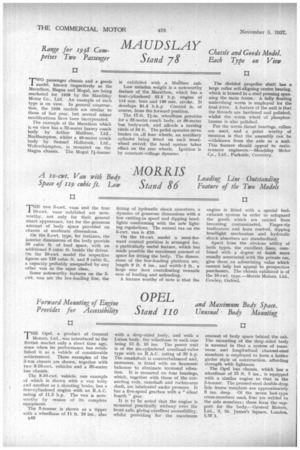OPHL
Page 56

If you've noticed an error in this article please click here to report it so we can fix it.
Stand 110
THE Opel, a product of General Motors, Ltd., was introduced to the British market only a short time ago, since when its performance has established it as a vehicle of considerable achievement. Three examples of the 3-ton chassis are shown, together with two 8-10-cwt. vehicles and a 26-seater bus chassis.
The 8-10-cwt. vehicle, one example of which is shown with a van body and another as a shooting brake, has a four-cyliudered engine with an R.A.C. rating of 11.3 h.p. The van is noteworthy by reason of its complete equipment.
The 3-tonner is shown as a tipper with a wheelbase of 11 ft. 10 ins., also E48 with a drop-sided body, and with a Luton body, the wheelbase in each case being 13 ft. 10 ins. The power unit is of the six-cylindered overhead-valve type with an R.A.C. rating of 30 h.p. The crankshaft is counterbalanced and, moreover, is fitted with an harmonic balancer to eliminate torsional vibration. It is mounted on four bearings, which, together with those of the connecting rods, camshaft and rocker-arm shaft, are lubricated under pressure. It has a five-speed gearbox with a "silent • fourth' gear.
It is to be noted that the engine is mounted practically midway over the front axle, giving excellent accessibility, whilst providing for the maximum amount of body space behind the cab. The mounting of the drop-sided body is unusual in that a system of transverse and longitudinal channel-steel members is employed to form a lattice girder style of construction, affording strength with lightness.
The Opel bus chassis, which has a wheelbase of 15 ft. 3 ins., is equipped with a similar engine to that in the 3-tonner. The pressed-steel double-drop hide frame 'members are approximately ins. deep. Of the seven boit-type cross-members used, four are welded to the side members ; these form the support for the body.—General Motors, Ltd., 3, St. James's Square, London, S.W.1.


















































































